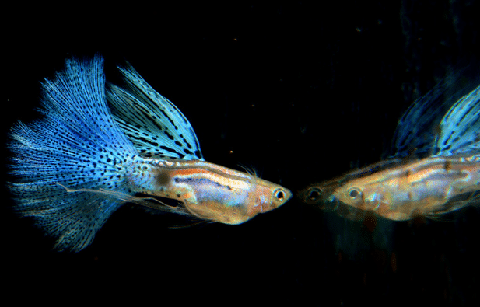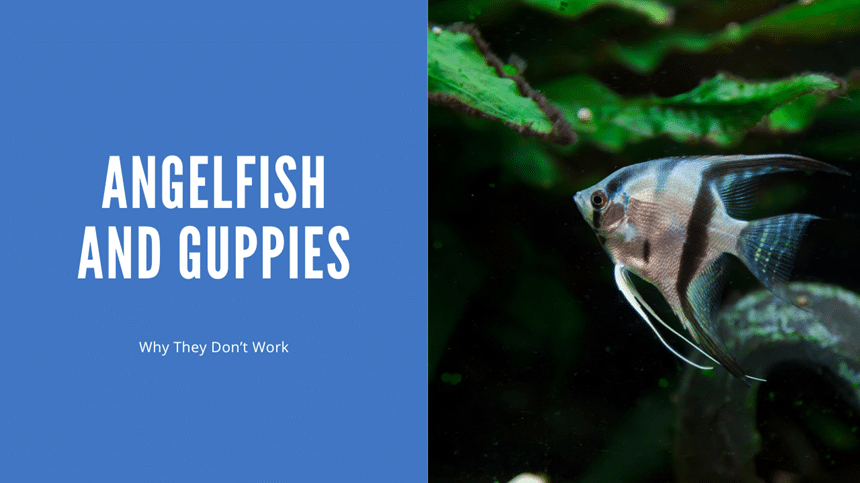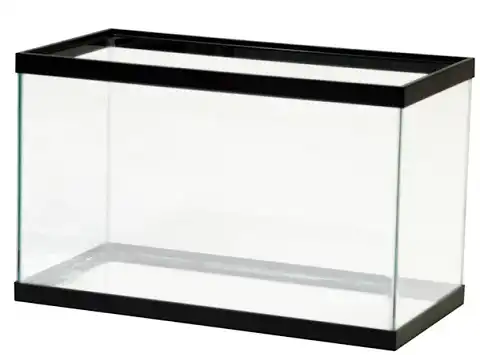Thank you for visiting! By the way… any links on this page that lead to products on Amazon and other stores/partners are affiliate links Aquarium Store Depot earns a commission if you make a purchase.
You might think that guppies are easy fish that can be kept with nearly any other species, right? While these small, hardy fish can get along with most fish species, they are not compatible with angelfish. Keep in mind that angelfish are a type of cichlid, and so they should be treated as such.
Here are the reasons why angelfish and guppies are not compatible, as well as some of the better angelfish tank mate alternatives.
Key Takeaways
- Angelfish and guppies are two beginner species that are incompatible with each other.
- Guppies like active, neutral conditions while angelfish thrive in stagnant, acidic environments.
- Angelfish can grow to moderate sizes and will eat smaller fish and fry.
- Some of the best tank mates for angelfish are tetras, rainbowfish, and other cichlids.
Intro To Angelfish
Before we can understand why guppies are incompatible with angelfish, we need to understand angel requirements on their own. These fish have been in the aquarium hobby for a long time, and the understanding of their care has changed throughout the decades.

Angelfish are a type of tropical cichlid. The most common species to find in the aquarium hobby is Pterophyllum scalare, but you may find others available in more specialized fish stores. These fish originate from the Amazon River system throughout South America, specifically from parts of Brazil, Colombia, and Peru. They are found in slow-moving waters, dense with vegetation. They prefer more acidic conditions, closer to blackwater environments.
Luckily, most angelfish available for sale have been commercially bred, which led to more ethical sourcing and better-controlled health. There are also many varieties of angelfish available, but most display plain colors of browns, blacks, and silvers. At adult size, they can grow to be 6 inches long and 8 inches tall. Some individuals even grow to an impressive 1 foot in height!
Tank Setup
There has always been a lot of discussion surrounding angelfish tank size. They aren’t overly active fish, but they can grow to considerable sizes and exhibit some aggressive behavior. Because of this, the current recommendation is a 40 gallon for keeping them with multiple angels or other fish species, and a 20 gallon for a pair. Because of their height, they are one of the few fish that do better in a tall aquarium than a long one.
This aquarium should have minimal water flow with plenty of plants and organics that lower the water pH.
Behavior
As a cichlid, these fish are mildly aggressive. They are not fast swimmers and will stick to the middle and upper portions of the water column. Male angels are likely to establish territories throughout the tank, especially during breeding periods. Females can be just as aggressive as males in some cases.
As slow swimmers, they are also slow eaters. This behavior is especially important to keep in mind when picking other tank mates as a shy angel could be outcompeted.
One last thing to consider is that, while semi-aggressive fish, angelfish can be skittish. Because of this, many hobbyists keep their angelfish aquariums dimly lit and stained with tannins.
Intro to Guppies
A guppy fish is likely to be one of the first tropical fish you ever get. These are small, hardy fish that bring a ton of color and excitement to the aquarium. They’re very forgiving of incorrect water parameters and will continue to breed regardless. All this, in addition to their wide availability and affordable price, make them a perfect beginner fish1.

That’s the problem, though: guppy fish are perfect beginner fish. What happens when you want to move on to more advanced species, like the angelfish? Can you keep guppies and angels in the same tank?
In most cases, guppy fish cannot be safely kept with angelfish. It might be hard to understand why, as these fish have many overlapping requirements, but we’ll see what makes these two fish species incompatible in the long run.
Mature Size
Guppy fish are small fish with males staying under 1.5 inches and females maxing out at around 2.5 inches. While this makes it so that a lot can be kept in a little, these tiny fish also make an enticing snack for larger angelfish.
Though unlikely, any fish is capable of eating something that can fit in their mouths. Small guppies, as well as guppy fry, are a quick and easy snack for a mature angelfish.
Tank Setup
Guppies can pretty much be kept in any aquarium setup imaginable, but the same cannot be said for angels. As mentioned before, angelfish prefer near-blackwater conditions in dim lighting conditions. While the two species enjoy an abundance of live plants, their compatibility in terms of tank setup ends there.
Guppy fish are often kept in neutral water parameters, with a pH near 7.0. While they can be acclimated to more acidic conditions, it’s best to keep fish close to their original environments. This is also true for the amount of water flow present in the fish tank. Guppies enjoy swimming against a current, whereas angels will be pushed into the corner by nearly any trace of water movement.
Another important aspect to keep in mind is that guppies are prolific breeders. The more space and resources they have, the more they will reproduce. In general, guppy fish can comfortably live in a 10 gallon aquarium. At one point or another, adult and/or baby guppies will need to be removed to maintain a healthy balance in the aquarium.
Your standard 10 gallon tank. Goes on sale at local Petcos for cheap
If placed in a very large tank, removing excess guppy fry can be difficult, even though your angelfish will likely help maintain populations. As we’ll see, an increase in guppies can lead to numerous problems for the angels in regard to opposing behaviors.
Behavior
On paper, it would seem that you could keep guppies and angelfish together. But when kept together in the same aquarium, these fish couldn’t be any more different.
Angelfish might as well have the exact opposite behavior as guppies. Angels are slow-moving and relatively reserved. Guppies are front-and-center and constantly moving! While this pairing of behaviors might work for other fish species, it does not work for these.

Guppies are simply too overbearing for angels. They stay in the same portions of the aquarium as angels and can stress angelfish out. Keep in mind that just because your angelfish is supposed to be semi-aggressive does not mean that you can’t get a shy one. This is especially true during feeding times when angelfish like to take their time and eat while guppies go into a frenzy. This incompatibility can lead to overly aggressive or starved angels.
While guppies aren’t aggressive fish, they have been known to be fin nippers. If an angelfish spends a significant amount of time in the upper water column, they may start to get bullied by the other guppies. This can be damaging as angelfish are already prone to snagging their extended finnage and developing fin rot. Similarly, an aggressive angel might chase and nip at pesky guppies that invade their territory.
While it might seem like guppies and angelfish can go in the same tank, the differences in their behaviors ultimately make them incompatible.
Why Angelfish and Guppies Don’t Work
Can you put guppies and angelfish together? No.
While these fish are two of the most popular fish species available, they cannot be kept in the same aquarium. This is because:
- Guppies are small, peaceful fish that can quickly become food for a larger angel. Guppy fry will also be regularly consumed by hungry angelfish.
- Angelfish prefer water parameters that resemble their natural habitat. This is slow-moving water with low pH. Guppy fish can be acclimated to a lower pH, but prefer a moving water current with near-neutral water quality. Angelfish also prefer dim settings while guppies shine under bright lights.
- Guppies can quickly overrun a larger fish tank as they are prolific breeders. A healthy balance between guppies and angels may be difficult to maintain while keeping parameters in check.
- Guppy fish and angelfish have opposite behaviors. Angels are large semi-aggressive fish that can bully smaller fish, or be bullied if the individual is shy. This is especially true during feeding times when guppies are quick to eat.
Better Alternatives
Though guppies and angelfish might not work together, there are plenty of ways to still use both of these species in their own respective community tank setup.
Some of the best guppy fish tank mates include:
Depending on the individual personality of your angel, you may be able to set up a community aquarium. If you have an angelfish that shows territorial behavior, then you may need to include some of the more aggressive species. Unfortunately, there is no way to tell how angelfish will react to new fish, so you might need to rehome tank mates if things don’t work out. To help avoid this, it’s recommended to add other fish to the tank before adding the angels.
Some community tank mate options for angelfish include:
- Corydoras catfish
- Gouramis
- Rainbowfish
If you have angels that display territorial behavior, then you might consider these tank mates instead:
- Severum
- Electric blue acara
- Kribensis
- Other angelfish
In order to keep a group of angelfish together indefinitely, fish should be added to the aquarium at the same time. At least 5 or more can comfortably be kept in a mid-size tank as long as there is a balance of males and females.
Can different species of angelfish be kept together in the same tank?
As mentioned before, there are a couple of different species of angelfish available in the aquarium hobby. One of these includes the relatively rare–and expensive–altum angelfish (Pterophyllum altum).
For the most part, hobbyists agree that these two species can be tank mates as long as a large tank is allowed. It is also recommended to add the two species together to help diffuse any possible aggression. A rehoming plan should be used in case the pairing doesn’t work out.
Which fish can be kept with angelfish?
Angelfish can be kept with certain tetras, gouramis, severums, or acaras. They cannot be kept with guppies and generally don’t do well with any species of livebearer.
What fish are compatible with guppies?
Angelfish can be kept in pairs with each other, in a community tank setup, or in a semi-aggressive setup. Depending on the plan you have for your tank, you may want to try breeding angels. Otherwise, your angel’s personality will decide whether you keep a community aquarium or a more predatory fish setup.
How many angel fish should be kept together?
Angelfish can be kept in pairs of two or in small groups of 5 or more. This will be determined by the size of your aquarium and the temperament of your fish.
Do angelfish eat other fish?
Angelfish have small mouths, but they will likely try to eat smaller tank mates. They will especially love trying to catch baby guppies!
Can you put angelfish with mollies?
While you can’t really keep guppies and angelfish together, do mollies work?
Many of the same concerns arise with mollies as when keeping angelfish with guppies: natural habitat differences, and opposing behaviors. However, mollies are considerably bigger than guppies and slightly less active. Full-grown angelfish will still see smaller mollies as snacks, but the two species are slightly more likely to be compatible tank mates in the long run.
Conclusion
Guppies and angelfish are two of the most popular beginner fish species available, but unfortunately, they do not make good tank mates. There are simply too many differences between preferred water conditions and behaviors that make it likely for either your angels or guppies to get hurt in the process. Depending on the personality of your angelfish, other suitable tank mates might be tetras, gouramis, corydoras, or other cichlids.
- About the Author
- Latest Posts
I’m thrilled that you found Aquarium Store Depot! Here you’ll find information on fish, aquariums, and all things aquatics related. I’m a hobbyist (being doing this since I was 11) and here to help other hobbyists thrive with their aquariums! I adhere to a high quality Editorial Process and Review products with real life field usage and practical analysis.






